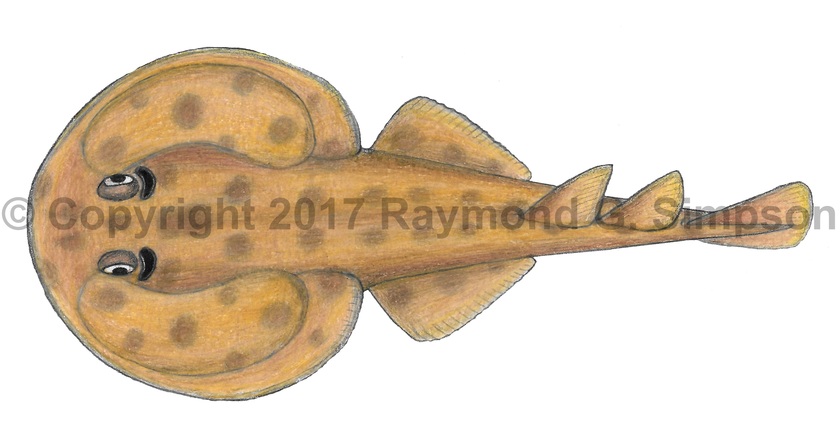
Common Name
Colombian Numbfish
Year Described
Fechhelm & McEachran, 1984
Identification
Disk small, thickened, and spoon-shaped with kidney-shaped electric organs under each pectoral fin base. Body quite flat along entire width. Mouth relatively small with well developed labial cartilage. Teeth small (~18 rows) and not visible when mouth is closed. Eyes large and projecting. Spiracles large with short papillae. Nostrils separated with a thin piece of cartilage with broad nasal curtain. Pectoral fins short. Tail a little longer than disk with low fleshy ridges. Dorsal fins about equal in size and rounded. Inter-dorsal space much shorter than length of dorsal base. Pelvic fins broad and long, without projecting anterior lobes. Pelvic fins not joined. Claspers very short and stout. Caudal fin rounded and quite small. Skin entirely smooth.
Color
Disk golden-yellow dorsally with large rounded brown spots covering the dorsum. Markings do not form concentric rings and there are no white spots. Ventrum whitish.
Size
A very small electric ray: maximum size to 17cm TL.
Habitat
Found at moderate to deep depths (30-100m) on continental shelves.
Range
Known only from off the coast of Colombia.
References
Compagno, L.J.V. 2002. Sharks. In: Carpenter, K.E. (Editor) FAO Identification Guide for Fishery Purposes. The Living Marine Resources of The Western Central Atlantic. Volume 1: Introduction, mollusks, crustaceans, hagfishes, sharks, batoid fishes, and chimaeras. ASIH Special Publication No. 5. FAO, Rome.
Last, P.R., White, W.T., Carvalho, M.R. de, Séret, B., Stehmann, M.F.W & Naylor, G.J.P (Eds.). 2016. Rays of the World. CSIRO Publishing, Melbourne.
Fechhelm, J.D. & J.D. McEachran. 1984. A revision of the electric ray genus Diplobatis with notes on the interrelationships of Narcinidae (Chondrichthyes, Torpediniformes). Bulletin of the Florida State Museum v. 29 (no. 5): 171-209.
Other Notes
The three species of West Atlantic Diplobatis are poorly known and the extent of their ranges are not well described. Diplobatis colombiensis and D. guamachensis appear to be allopatric but appear to differ significantly only in color pattern. Diplobatis picta overlaps the range of D. guamachensis on the coast of Venezuela. Fechhelm & McEachran (1984) consider all three species as subspecies or regional forms of Diplobatis picta. More study is needed to determine the validity of each species.